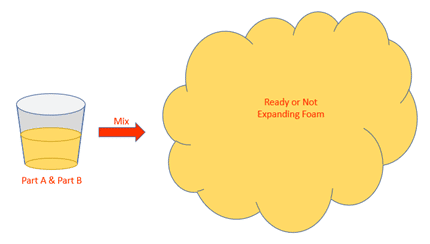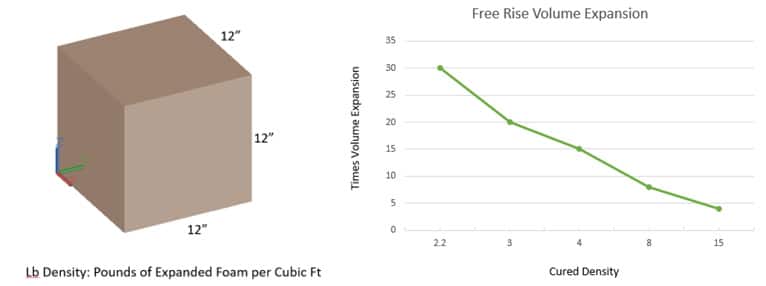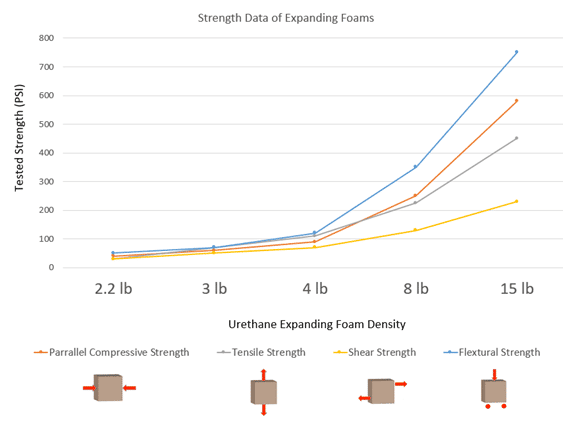
Expanding foams are classified by their density upon expansion. The expanded or cured density of the foam determines how strong or how much a given foam will expand. The un-mixed liquids (Parts A & B) of the Urethane Foams are the same for nearly all types. However, upon the start of mixing, coloration of the urethane foam will become a creamy like color and expansion will soon start to occur (usually between 30 and 60 seconds). Sometimes this is rapid expansion, depending on the type. Composite Envisions offers five choices in expandable urethane foams ranging from 2.2 to 15 lb density (per cubic foot) each being unique in their characteristics and uses.

Free Rise Volume Expansion is how much a respective foam will expand during its cure process. As shown above the lighter density foams will fill more volume and expand at quicker rates. The 2.2 lb density foam will expand nearly 30x its original unmixed volume while the 15 lb will only fill roughly 4x that. But how does this corelate to strength and how to choose the best expanding foam for a specific application?

As the above strength testing results are displayed, it is apparent that (2) categories can be formed. (2.2 / 3 / 4) lb density foam is mainly used for non-structural applications while (8 / 15) lb density foam would be more suitable for loading and structural applications.
2.2 Lb Density Foam – (Highest Expansion Rate) Used mainly for floatation needs and in void & cavity filling below decks. Examples- The Marine and Boating Industry uses this density in boats as hull cavities can be filled with this light-weight foam. In addition, pontoons or other floating structures may be filled with this expanding foam. These light-weight foams aid in ensuring an “unsinkable” hull can be obtained. Even if a puncture occurs in many of these boats, the floatation adding foam will ensure the boat stays buoyant even if it were to be punctured. Floatation foam often doubles as insulation and is commonly used for stabilizing temperatures in coolers, and live wells.
3 Lb Density Foam – High Expansion Rate and a higher degree of filling qualities to mold surfaces makes this density more suitable for carving & sculpting applications. This density is also used for floatation but it is slightly heavier, offering better insulating properties than the 2.2 lb density. As fish preservation is a top part of many tournament bass fishermen, this foam will aid greatly in keeping temperatures within live wells more stable, aiding in keeping fish healthy and comfortable on long hot days on the water.
4 Lb Density Foam – Of the non-structural foams, 4lb density can do all that 2.2 or 3 lb can but 4lb will have the best detail in filling characteristics. 4lb is not as light as the above choices so it makes most suitable use for jobs in Taxidermy, Casting, and Sculpting.
8 Lb Density Foam – Highly rigid, offering additional structural options, exhibits more durable characteristics and will not be easily dented by hand. Castings can be made in high detail. Castings of this material may then be used to wrap with a fabric & resin, giving an endless option to a part’s design. Uses are not limited to but include carving, sculpting, and even sign making. 8 lb density foam is often used in the Fishing Rod Industry for Carbon Fiber / Epoxy handles, promoting a high degree of sensitivity in a rod blank.
15 Lb Density Foam – The strongest and most rigid in expanding foam selection. This foam is simply HARD. Castings are often made when strength is needed in the application. This foam does not expand as rapidly nor is it light when comparing it to other foams. This heavier density will however provide in finest detail in castings, add strength in beams, pole setting, construction and other structural applications.
First, make sure all the necessary items needed for the job are organized neatly out and in front. Pouring and expansion is only a small amount of the work that goes into using these foams and it is quick. However, proper setup of the area, work on any mold surfaces, masking areas off correctly and beforehand is critical for a successful job before the top of the urethane foam is mixed. If using a mold, casting blank, or equivalent ensure it is properly coated in a release agent or other means of separating such as wax paper or composite separating film.
Items Needed
Ideal temps for mixing and keeping consistent expansion rates is between 75º to 80º F. Going above will not hurt anything much but going too far below these set temps will influence how much a given foam will expand.
Accurate measuring of the (2) parts is critical in achieving proper cure properties of any of the foam(s). By volume this is made easy, using a 1 to 1 ratio. Once measured out and put in the same cup the expanding foam will not immediately start foaming upon encountering its counterpart. The 2 parts must be adequately mixed. As mixing, a color change will occur within the liquid. It will turn from a brown to a light cream color, and this is evidence of the foam being close to “kicking off”. This is the time that the pouring will need to occur. There should be a solid 20 seconds or so before the expansion starts. It will suddenly begin to grow into filling whatever cavity or structure is placed into. The initial expansion will occur rather quickly and within (~5) minutes the expansion process will be complete. As there will probably be extra coming from the mold surface, test to ensure the foam is tack free before removing any of the mold / casting surfaces.
If the foam did not fill the cavity, there is not any need to worry, more can be mixed and poured on top to fill as needed.
Once the foam shape has been achieved and stripped from the respective casting / mold surfaces, these foams can be covered by most any fabric and resin combination. This is where the final possibilities of this product may really take shape as being unlimited. Urethane Foams can be laminated over with Epoxy, Polyester, and Vinyl Ester resins. In turn Foam structures used as a “core” can be “skinned” and transformed into structural parts ending in high-quality composite parts.
